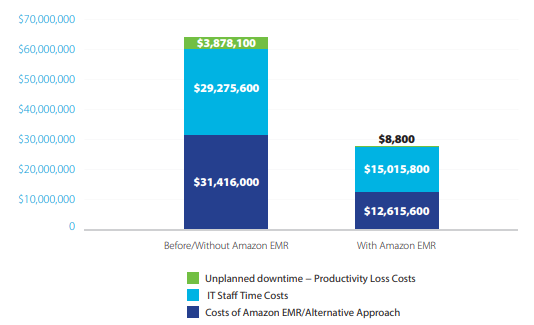Over the last few years, the hype surrounding cloud technology has reached the ‘slope of enlightenment, with more and more organizations today adopting Cloud as a key part of their IT strategy. With increased cloud usage, organizations are slowly waking up to a cloud hangover from the unaccounted cloud billing.
Traditionally, companies relied on in-house data center facilities that required a hefty capital investment as they purchased space, equipment, software, including manpower to run and maintain infrastructure. If we consider the technology landscape today, organizations are typically data-driven and utilize data lake technologies that offer great benefits to enterprises seeking to maximize value. Managing these technologies in the data center poses a challenge leading to increased overheads. A better option is to deploy these technologies in a managed cloud service optimized to gain full visibility into cloud spending. The cloud data lake provides flexibility in compute and storage usage in addition to a range of cost-variable service offerings.
Cost Analysis of Hadoop Clusters in Cloud:
Appropriate cost analysis needs to be done when assessing solutions for your business. One way is to compare two financial models — capital expenditure (cap-ex) and operating expenditure (op-ex). For companies that have historically used cap-ex and those that value predictability of spend, variable monthly charges and cloud usage can come as a big surprise. Cloud technology typically employs the op-ex model wherein there isn’t a long-term commitment. The true question is not which option costs more per measurement unit but rather which option is the least expensive over the total usage of the resource.
IDC published a white paper in November 2018 to evaluate the total cost of operations of Amazon EMR against an on-premise environment over a five-year period. The end result was a massive 57% drop in TCO over 5 years.
 Source: IDC White Paper 2018 | The Economic Benefits of Migrating Apache Spark and Hadoop to Amazon EMR
Source: IDC White Paper 2018 | The Economic Benefits of Migrating Apache Spark and Hadoop to Amazon EMR
Organizations running their Big Data/Hadoop/Spark environments on cloud systems such as Amazon EMR can have a significantly lower total cost of operations against a comparable on-premise infrastructure. Here are three reasons why:
Lower IT infrastructure costs: A major benefit of cloud usage is lower IT infrastructure costs. This benefit relates to the cloud’s pay-per-use, flexible pricing models. The overall savings over on-premise IT infrastructure costs such as costs of power, cooling and facilities space are considerable. There is no need to keep servers up and running without workload, especially during off-peak work hours or idle time.
Better risk mitigation: Cloud improves risk profiles by offering high levels of availability and reducing unplanned downtime, which directly translates to organizations reducing revenue lost due to these factors.
Better risk mitigation: Cloud improves risk profiles by offering high levels of availability and reducing unplanned downtime, which directly translates to organizations reducing revenue lost due to these factors.
Increased IT staff productivity gains: IT management is much easier and efficient in a managed cloud service environment. Teams can be more aligned with strategic projects in support of business goals instead of other ancillary tasks associated with Hadoop or Spark environments.
Let’s consider an example of a cloud service such as Amazon EMR. Following are the advantages that Amazon EMR offer over on-prem Hadoop systems:
-
Using Amazon S3 as storage instead of HDFS causes a huge cost variation since the former is considerably cheaper. This alone reduces the total cost of ownership (TCO)
-
One of the big advantages of cloud computing is the auto-scaling feature. Clusters in cloud can be scaled up or down automatically depending upon computational needs of the current workload. If there is no job running, the cluster shuts down automatically which reduces costs significantly
-
Cost efficiency for batch analytics and ad-hoc query workloads. Worker nodes can be scaled-out as required and scaled back in when no longer needed for long-running clusters, while an entire cluster can be spun up and shut down for shorter, ad-hoc workloads
-
Moving to cloud systems reduces operational overhead costs of maintaining Hadoop clusters- meaning leaner teams that can focus on solving real business problems
Conclusion
Cost comparisons between cloud versus on-prem infrastructures are complex and heavily dependent on the specific solution being deployed. Organizations need to adopt a strategic and holistic approach to cloud deployment to achieve maximum cost benefits from the latest cloud developments. A hybrid structure can often help in splitting the loads between on-prem and cloud-based on functional aspects. As a trusted partner, Clairvoyant offers a broad set of cost-effective cloud solutions to improve business efficiency in a highly secure manner. You get a comprehensive data management solution that gives you a competitive advantage, allows you to expand your customer base, and grow your business profitably. To get the best cloud IT solutions, contact us at clairvoyant.
For more information or further queries, please email us at sales@clairvoyantsoft.com or call us at (623)282–2385. Learn more at: https://www.clairvoyant.ai/
References:
Olofson C, Singh H., (November 2018), IDC White Paper — The Economic Benefits of Migrating Apache Spark and Hadoop to Amazon EMR. Retrieved from: https://d1.awsstatic.com/analyst-reports/IDC%20Economic%20Benefits%20of%20Migrating%20to%20EMR%20White%20Paper.pdf
Marden M, Olofson C., (December 2015), IDC White Paper — The Business Value and TCO Advantage of Apache Hadoop in the Cloud with Microsoft Azure HDInsight. Retrieved from: https://3er1viui9wo30pkxh1v2nh4w-wpengine.netdna-ssl.com/wp-content/uploads/2017/04/IDC-Business-Value-TCO-Advantage-Hadoop-with-Azure-HDInsight.pdf